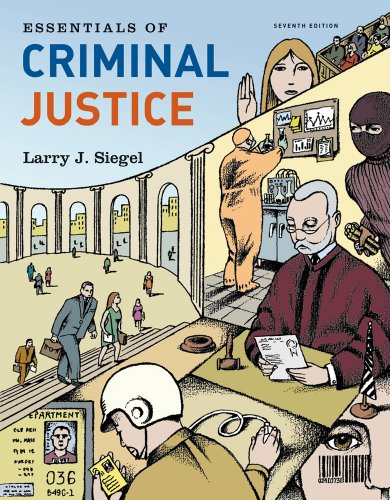(EBOOK PDF)Essentials of Criminal Justice 7th Edition by Larry Siegel 0495810991 9780495810995 full chapters
$50.00 Original price was: $50.00.$35.00Current price is: $35.00.
Essentials of Criminal Justice 7th Edition by Larry Siegel – Ebook PDF Instant Download/Delivery: 0495810991, 9780495810995
Full download Essentials of Criminal Justice 7th Edition after payment

Product details:
• ISBN 10:0495810991
• ISBN 13:9780495810995
• Author:Larry Siegel
Master the ins and outs of the criminal justice system and succeed in your course with ESSENTIALS OF CRIMINAL JUSTICE, Seventh Edition! With its cutting-edge high-profile cases, detailed career information and resources, integrated learning objectives, and unique myth-busting theme, this text and its supporting resources will help you excel in this course and beyond.
Essentials of Criminal Justice 7th Table of contents:
Part 1. The Nature of Crime, Law, and Criminal Justice
A Study Skills Module
Skill Prep. A Study Skills Module
What’s Inside
Life Prep
Time Prep
Study Prep
Test Prep
Read Prep
Write Prep
Chapter 1. Crime and Criminal Justice
Developing the Criminal Justice System
The Modern Era of Justice
Federal Involvement in Criminal Justice
Evidence-Based Justice: A Scientific Evolution
The Contemporary Criminal Justice System
The Formal Criminal Justice Process
The Criminal Justice Assembly Line
The Informal Criminal Justice Process
The “Wedding Cake” Model of Justice
Perspectives on Justice
Crime Control Perspective
Rehabilitation Perspective
Due Process Perspective
Nonintervention Perspective
Equal Justice Perspective
Restorative Justice Perspective
Perspectives in Perspective
Ethics in Criminal Justice
Ethics and Law Enforcement
Ethics and the Courts
Ethics and Corrections
Summary
Key Terms
Review Questions
Chapter 2. The Nature of Crime and Victimization
How Is Crime Defined?
Consensus View
Conflict View
Interactionist View
How Is Crime Measured?
Official Crime Data: The Uniform Crime Reports (UCR)
National Crime Victimization Survey (NCVS)
Self-Report Surveys
The Pros and Cons of the Crime Data Sources
Crime Trends
Trends in the Uniform Crime Reports
Trends in the Victimization Data
Self-Report Trends
Crime Patterns
Ecological Patterns
Gender Patterns
Racial Patterns
Social Class Patterns
Age Patterns
Career Patterns: The Chronic Offender
Victim Patterns
Causes of Crime and Victimization
Rational Choice Theory
Biosocial Theory
Psychological Theory
Social Structure Theory
Social Process Theory
Social Conflict Theory
Developmental Theory
Summary
Key Terms
Review Questions
Chapter 3. Criminal Law: Substance and Procedure
Historical Development of the Criminal Law
Common Law and the Principle of Stare Decisis
Sources of Criminal Law
Constitutional Limits
Crimes and Classifications
The Legal Definition of a Crime
Actus Reus
Mens Rea
The Relationship between Mens Rea and Actus Reus
Ignorance and Mistake
Strict Liability
Criminal Defenses
Excuse Defenses
Justification Defenses
Changing Defenses
The Evolution of Criminal Law
Creating New Crimes
Constitutional Criminal Procedure
Due Process of Law
Interpreting the Constitution
Summary
Key Terms
Review Questions
Part 2. The Police and Law Enforcement
Chapter 4. Police in Society: History and Organization
The History of Police
Private Police and Thief Takers
Creating Public Police
Law Enforcement in Colonial America
Early Police Agencies
Policing in the Modern Era
The Emergence of Professionalism
The 1960s and Beyond
The President’s Task Force on 21st Century Policing
Policing and Law Enforcement Today
Federal Law Enforcement Agencies
State Law Enforcement Agencies
County Law Enforcement Agencies
Metropolitan Law Enforcement Agencies
Private Policing
Technology and Law Enforcement
Identifying Criminals
Locating Criminals
Crime Scene Investigation
Crime Mapping
Biometrics
DNA Testing
Social Media and Networking
Predictive Analytics
Summary
Key Terms
Review Questions
Chapter 5. The Police: Role and Function
The Police Organization
Pros and Cons of Police Organization
The Police Role
The Patrol Function
Patrol Activities
Improving Patrol
The Investigation Function
How Do Detectives Detect?
Sting Operations
Evaluating Investigations
Improving Investigation with Technology
Improving Investigations with Forensic Science
Community-Oriented Policing
Implementing Community-Oriented Policing
Changing the Police Role
Challenges of Community-Oriented Policing
Community-Oriented Policing Effectiveness
Problem-Oriented Policing
Intelligence-Led Policing
Fusion Centers
Support Functions
Summary
Key Terms
Review Questions
Chapter 6. Issues in Policing: Professional, Social, and Legal
Who Are the Police?
Demographic Makeup
Minority Police Officers
Women in Policing
Educational Characteristics
The Police Profession
Police Culture
The Police Personality
Policing Style
Police Discretion
Legal Factors
Environmental Factors
Departmental Factors
Peer Factors
Situational Factors
Extralegal Factors
Problems of Policing
Job Stress
Fatigue
Violence and Brutality
Corruption
Use of Force
Deadly Force
Nondeadly Force
Less-Lethal Weapons
Police Searches and Interrogations
Interrogation and Confessions
Search and Seizure
The Exclusionary Rule
Summary
Key Terms
Review Questions
Part 3. Courts and Adjudication
Chapter 7. Courts, Prosecution, and the Defense
State Courts
Courts of Limited Jurisdiction
Courts of General Jurisdiction
Appellate Courts
Federal Courts
US District Courts
US Courts of Appeals
The US Supreme Court
The Judiciary
The Judge and the Justice System
Judicial Qualifications and Selection
The Prosecutor
Types of Prosecutors
Prosecutorial Discretion
Factors Influencing Prosecutorial Discretion
The Pros and Cons of Prosecutorial Discretion
Prosecutorial Ethics
Prosecutorial Misconduct
The Defense Attorney
The Role of the Criminal Defense Attorney
The Right to Counsel
Legal Services for the Indigent
The Private Bar
Does the Type of Lawyer Matter?
The Competence of Defense Attorneys
Court Administration
Using Technology in Court Management
Summary
Key Terms
Review Questions
Chapter 8. Pretrial and Trial Procedures
Bail
Right to Bail
Bail Release Mechanisms
Types of Bail
Bail Issues
Charging the Defendant
The Indictment Process and the Grand Jury
The Information Process and the Preliminary Hearing
Arraignment
The Plea
Plea Bargaining
Pros and Cons of Plea Negotiation
Legal Issues in Plea Bargaining
Plea-Bargaining Decision Making
Plea-Bargaining Reform
Pretrial Diversion
The Trial
Legal Rights During Trial
The Trial Process
Summary
Key Terms
Review Questions
Chapter 9. Punishment and Sentencing
The History of Punishment
From Exile to Fines, Torture to Forfeiture
Public Work and Transportation to the Colonies
The Rise of the Prison
The Goals of Modern Sentencing
Deterrence
Incapacitation
Retribution/Just Desert
Rehabilitation
Equity/Restitution
Sentencing Models
Indeterminate Sentences
Determinate Sentences
Mandatory Sentences
Imposing the Sentence
Concurrent versus Consecutive Sentences
The Effect of Good Time
How People Are Sentenced
What Factors Affect Sentencing?
Capital Punishment
Arguments for the Death Penalty
Arguments Against the Death Penalty
Legal Issues in Capital Punishment
Summary
Key Terms
Review Questions
Part 4. Corrections and Alternative Sanctions
Chapter 10. Community Sentences: Probation, Intermediate Sanctions, and Restorative Justice
What Is Probation?
The History of Probation and Community Sentencing
John Augustus and the Creation of Probation
Probation Today
Awarding Probation
Probation Eligibility
Conditions of Probation
Administration of Probation Services
Elements of Probation
Legal Rights of Probationers
How Successful Is Probation?
How Successful Is Felony Probation?
Who Fails on Probation and Who Succeeds?
The Future of Probation
Intermediate Sanctions
Fines
Forfeiture
Restitution
Shock Probation and Split Sentencing
Intensive Probation Supervision
House Arrest
Electronic Monitoring
Global Positioning System (GPS) Monitoring
Residential Community Corrections
Restorative Justice Programs
The Concept of Restoration
Restoration Programs
Restoration in Practice
The Challenge of Restorative Justice
Summary
Key Terms
Review Questions
Chapter 11. Corrections: History, Institutions, and Populations
The History of Correctional Institutions
The Origin of Corrections in the United States
The New York and Pennsylvania Systems
Corrections in the Nineteenth Century
Prisons in the Twentieth Century
Contemporary Correctional Institutions
Jails
Jail Populations and Trends
Jail Conditions
Suicide
New-Generation Jails
Prisons
Types of Prisons
Inmate Population Trends
Profile of the Prison Inmate
Alternative Correctional Institutions
Prison Farms and Camps
Shock Incarceration in Boot Camps
Community Correctional Facilities
Private Prisons
Summary
Key Terms
Review Questions
Chapter 12. Prison Life: Living in and Leaving Prison
Men Imprisoned
Coping in Prison
Sexual Coercion
The Inmate Social Code
The New Inmate Culture
Women Imprisoned
Female Institutions
Female Inmates
Adapting to the Female Institution
Correctional Treatment
Individual and Group Treatment
Educational Programs
Vocational Programs
Can Rehabilitation Work?
Correctional Officers
Female Correctional Officers
Prison Violence
What Causes Prison Violence?
Prisoners’ Rights
Substantive Rights
Leaving Prison: Parole
Is There a Legal Right to Parole?
Parole Effectiveness
Supervision on the Outside
The Problem of Reentry
Why Do People Fail on Parole?
Improving Chances on Reentry
Summary
Key Terms
Review Questions
Part 5. Contemporary Issues in American Criminal Justice
Chapter 13. Juvenile Justice in the Twenty-First Century
The History of Juvenile Justice
Care of Children in Early America
The Child-Saving Movement
The Refuge Movement Spreads
Establishment of the Juvenile Court
The Development of Juvenile Justice
Juvenile Justice Today
Police Processing of the Juvenile Offender
Use of Discretion
Legal Rights
The Juvenile Court Process
The Intake Process
The Detention Process
Bail
Plea Bargaining
Waiver of Jurisdiction
Adjudication
Disposition and Treatment
Juvenile Sentencing Reform
The Juvenile Correctional Process
Probation
Institutionalization
Deinstitutionalization
Aftercare
Problems of Juvenile Justice
Minority Overrepresentation in Juvenile Justice
Preventing Delinquency
Summary
Key Terms
Review Questions
Chapter 14. Crime and Justice in the New Millennium
Terrorism
Defining Terrorism
Terrorist Goals and Objectives
Fighting Terrorism
Corporate Enterprise Crime
Fraud on Wall Street
Criminalizing Corporate Enterprise Crime
Green Crime
Forms of Green Crime
Enforcing Environmental Laws
Cybercrime
Cybertheft: Cybercrimes for Profit
Cybervandalism: Cybercrime with Malicious Intent
Cyberbullying
Cyberwarfare
Controlling Cybercrime
Enforcing Cyber Laws
Globalization and Transnational Organized Crime
Transnational Organized Crime
Types of Transnational Crimes
Transnational Crime Groups
Controlling Transnational Crime
Why Is It So Difficult to Eradicate Global Crime?
Summary
Key Terms
Review Questions
People also search for Essentials of Criminal Justice 7th:
essentials of criminal justice
essentials of criminal justice 11th edition pdf
essentials of criminal justice 11th edition free
essentials of criminal justice 11th edition pdf free
essentials of criminal justice 10th edition
Tags:
Essentials of Criminal,Criminal Justice,Larry Siegel


